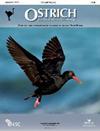非洲热带森林和林地中食虫鸟类的混合种群(“鸟类派对”):综述
IF 1.3
4区 生物学
Q2 ORNITHOLOGY
引用次数: 2
摘要
觅食食虫鸟类的混种群在世界各地都有发现,在新热带地区研究得最好。一项对已发表文献的调查显示,在整个非洲热带地区的森林和林地栖息地,经常会遇到由2-30种鸟类组成的混合物种群(通常称为“鸟类聚会”),有时会遇到100 - 70只鸟。在非洲大陆,据报道有59个科的近600种鸟类生活在这样的鸟群中,至少有300种鸟类在这样的鸟群中觅食可能是它们捕食活动的重要组成部分。在马达加斯加,已记录到19科的bb60种混合物种群,其中40多种经常参与。这些觅食团体主要是拾取和觅食食虫鸟类,其他觅食团体的种类和个体较少。解释鸟类参与这种鸟群的主要假设强调了在寻找食物时保护自己免受捕食者的侵害,以及通过鸟群成员不同的觅食活动引起的昆虫干扰来提高觅食效率。某些关键物种可能负责鸟群的初始形成。混合物种群被认为特别容易受到人为生境变化的破坏,特别是对森林的破坏,因此特别值得关注。在非洲热带地区,这些建议仍然是有效的假设,因为我们目前缺乏充分评估混合物种群的生态作用及其在参与物种生活史中的重要性的数据。本文章由计算机程序翻译,如有差异,请以英文原文为准。
Mixed-species flocks of insectivorous birds (‘bird parties’) in Afrotropical forests and woodlands: a review
Mixed-species flocks of foraging insectivorous birds are found worldwide and have been best studied in the Neotropical region. A survey of the published literature reveals that mixed-species flocks (often termed ‘bird parties’) comprised of 2–30 species and sometimes >70 individual birds are regularly encountered in forest and woodland habitats throughout the Afrotropical region. On mainland Africa, >600 species representing 59 bird families have been reported in such flocks, and for at least 300 species foraging in such flocks may constitute an important part of their feeding activity. In Madagascar, >60 species of 19 families have been recorded in mixed-species flocks, with more than 40 species frequent participants. These foraging parties are dominated by gleaning and sallying insectivorous birds, with other feeding guilds represented by fewer species and individuals. The main hypotheses to explain why birds participate in such flocks emphasise protection from predators while searching for food, and increased foraging efficiency through the disturbance of insects caused by the different foraging activities of flock members. Certain key species may be responsible for the initial formation of the flock. Mixed-species flocks are regarded as particularly vulnerable to disruption by anthropogenic habitat changes, especially to forests, and are thus of special conservation concern. In the Afrotropics, these proposals remain working hypotheses since we currently lack data for a full assessment of the ecological role of mixed-species flocks and their importance in the life history of the participating species.
求助全文
通过发布文献求助,成功后即可免费获取论文全文。
去求助
来源期刊

Ostrich
生物-鸟类学
CiteScore
2.10
自引率
30.00%
发文量
24
审稿时长
>12 weeks
期刊介绍:
Ostrich: Journal of African Ornithology is the leading ornithological journal in Africa, and publishes peer-reviewed scientific papers and short communications (
 求助内容:
求助内容: 应助结果提醒方式:
应助结果提醒方式:


